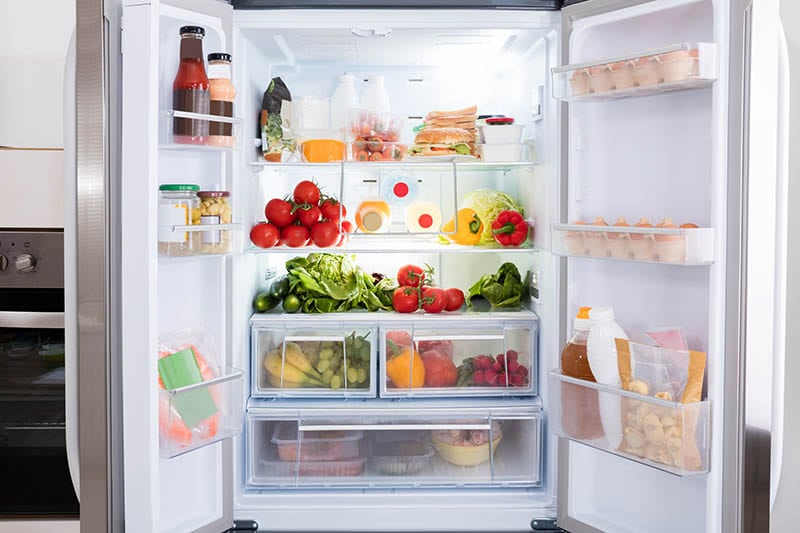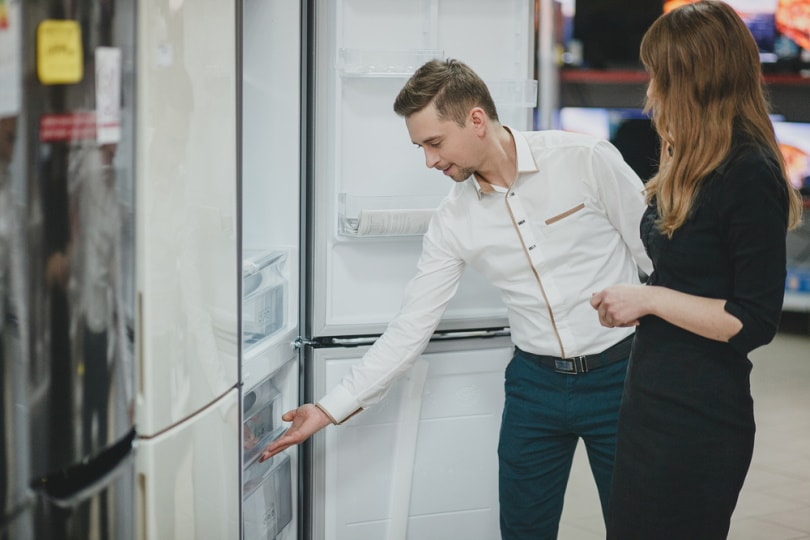Who Invented the Refrigerator? History, Facts, & FAQ
-
Pete Ortiz
- Last updated:

The refrigerator is, without a doubt, an essential household appliance in every home. Most of us like to take it for granted, but as soon as the lights go out, we’re immediately reminded of our food’s safety. And while we admit it’s there to serve several other purposes, its prime objective is and will always be to prevent the growth of bacteria. The refrigerator was invented by William Cullen in 1748.
The goal of today’s article is to turn back the hands of time so that we can learn about the history of this beautiful piece of equipment. This is not going to be one of those boring history classes, so pay close attention.
The First Application of Refrigeration
Even though refrigeration has always been associated with the modern era, those living in ancient times were well-acquainted with the process. They didn’t have the fancy pieces of equipment that we have now, but they were smart enough to know it’s possible to keep food from rotting by freezing it.
They took advantage of underground pits, streams, lakes, rivers, and all the other cold-water sources that could act as natural refrigerators, to preserve their food. Harvesting ice was a daunting task, so necessity bred our current invention.

The Invention of The Refrigerator: Timeline
1700–1800
In 1748, we were introduced to a machine that had the ability to keep things frozen. And the guy who made the introductions was William Cullen, a Scottish College Professor. He taught medicine, but he also dabbled in a few other things like chemistry, physics, and agriculture.
The prototype that Cullen built is regarded as the foundation of modern refrigeration, seeing as it’s the blueprint that manufacturers still use to design new iterations. That equipment was relatively smaller in size, had a pump, and a tiny container filled with diethyl ether.
Diethyl ether is an organic compound that was once used as an anesthetic agent. Our physicians had to replace it with a different substance because it was highly inflammable¹, making it incompatible with our advanced surgical and anesthetic procedures. Today, it’s mostly used as a solvent in the production of plastics and synthetic dyes.
The work of the pump was to lower the ether’s boiling point, by creating a vacuum in the container. And as the ether started boiling, it slowly absorbed the heat in the air surrounding it.
1800–1900
Besides Cullen, nobody else tried to work on an improved version of the refrigerator in the 1700s. Most people thought that was it, up until 1805 when Oliver Evans (an engineer and businessman from Delaware) came up with the closed vapor-compression refrigeration cycle idea. But this prototype didn’t have any other major adjustment, as we’ve learned that it also relied on ether.
Were his ideas and prototypes practical in the real world? Sadly, no.
And they weren’t up until 1834, when Jacob Perkins stepped in, and successfully designed a functional vapor-compression system. This one was special and practical in the sense that there was no observable inefficiency or waste in its operations, on top of the fact that the cycle was closed.
Regrettably, when it came to its commercial application, the whole thing was an utter failure. Lucky for us these developments enticed more people to give it a go, including John Gorrie, who was an American Physician.
It was Gorrie who built a different design in 1842, with the chief objective of applying it in tropical homes. Needless to say, that whole project also joined the long list of commercial failures in history.
The first real progress was made in 1851 by James Harrison. This British journalist—who was an Australian immigrant at the time—figured out a totally different way of going about things, and meticulously executed his mechanical ice-making plan. He’s the guy credited for giving us our first commercial refrigerator.
James wasn’t in a rush to let the world know he had a eureka moment in 1851. By the time we got wind of this information, it was 1854, and he was working to patent it. He got the patent 2 years later, and that’s how the refrigerators found their way into meat-packing houses and breweries.
It also used ether, but unlike the previous versions, it was designed to use ammonia and alcohol as alternatives. Years later, they replaced all that with methyl chloride and sulfur dioxide to facilitate efficiency.
1900–2000
The first refrigerators weren’t efficient enough to be used in homes. Fred W. Wolf solved this problem in 1913 when he built a sleek unit designed to be mounted on an ice box. More than a year later, Nathaniel B. Wales invented a different unit, one which was solely powered by electricity.
The technological advancements present during this era are the reason why new models were being released at a faster rate. We were introduced to yet another idea in 1916, by one Alfred Mellowes. He felt it was more efficient and aesthetically pleasing to have the compressor of the then-model placed at the bottom of the cabinet.
Seems like most inventors agreed with him because that idea finally became a working system in 1918, courtesy of the Frigidaire Company. Not long after, they started mass-producing and selling their models to consumers willing to reduce food wastage through new technology. The Kelvinator Company also wanted a piece of the pie, so they started manufacturing refrigerators as well.
To ensure their products stood out, they decided to go with Nathaniel B. Wales’ model but added automatic temperature controls. Their strategy worked for sure, as it’s estimated that they controlled an 80% electric refrigerator market share¹ by 1923.
These new refrigerator models got the entire world so excited that even the Swedes started looking for ways to contribute in 1922. Two of their engineers, Carl Munters and Baltzar von Platen, were the ones who came up with this incredible idea of powering the cooling system using heat energy. They called this invention the “absorption refrigerator,” and it had a cold box in the kitchen, while the motor and compressor went in the basement.
Having different parts of a refrigerator in different rooms of the house didn’t augur well with most of their consumers, so Frigidaire solved that problem for them in 1923. It’s credited as being the first company to make the first self-contained “absorption refrigerator” in the world.
Of all the prototype designs released, the most popular iteration was the General Electric “Monitor-Top” refrigerator¹, which was manufactured in 1927. From what we’ve heard, they settled on that name because its compressor looked a lot like the gun turret found on the infamous Civil War ironclad ship. The only issue that came with this new release was that of the refrigerating medium.
At the time, it could only use methyl formate or sulfur dioxide, which are toxic and dangerous to humans. So, a team of professionals was established to find a safer solution, even if it wasn’t 100% risk-free. That’s how freon became the GE “Monitor Top” refrigerator’s medium.
Freon was stable, nonflammable, and mildly toxic. Decades later, it became apparent to everyone that it was also responsible for the depletion of our atmosphere’s ozone layer. So, they had no other choice but to replace it with another refrigerator medium.
Interesting Facts About Refrigerators
- 30th October is Haunted Refrigerator Night. That date has been conveniently set a day before Halloween so that everyone who owns a refrigerator can celebrate the horrors that live deep within their icebox.
- The 15th¹ day of November is also a holiday, known as National Clean Out Your Fridge Day. It’s important to clean your refrigerator every so often, as it can quickly turn into a breeding ground for bacteria or even mold.
- It is estimated that the refrigerator business generates more than 100 billion U.S. dollars¹ annually, in revenue. To put it into context, that’s enough money to educate more than 750,000 college students, for 4 years.
- It’s virtually impossible for food stored under 0ºF (-18ºC)¹ to go bad. At that temperature, even if the food had some bacteria in it, the conditions would prevent it from growing. However, that doesn’t prevent the food quality from being compromised.
- In Pennsylvania¹, you are prohibited from sleeping on top of a fridge, while you’re outside. If you wish to take a quick nap, open the refrigerator doors, and make yourself comfortable.

Frequently Asked Questions (FAQ)
Why Don’t We Have A “D” In the Word “Refrigerator?”
If you’re wondering why the word “fridge” has a “D” but it’s missing in “refrigerator,” you’re not alone. First off, it is important to note that the word “refrigerator” is a Latin derivative of refrigerare. This word is also a modification of another frigus, which is a Latin adjective that describes the cold.
If you get the chance to go through the old publications, you’ll realize that those writers didn’t call the appliance a fridge but frig. The spelling only changed when some of them felt it was time to spell it the same way they were spelling words with similar syllables. For example, fudge, ledge, bridge, etc.
How Do You Prolong the Lifespan of a Refrigerator?
Don’t be one of those people who only think about cleaning the refrigerator once it starts emitting an unpleasant odor. You have to clean all the parts at least twice every week, to prevent the growth of mold and bacteria.
And always check the freezer vents just to be sure there’s proper air circulation. This will guarantee the refrigerator serves you for close to 20 years.
Should I Buy or Repair My 10-Year-Old Refrigerator?
A 10-year-old refrigerator has already served its purpose. Given the average lifespan of a refrigerator is 10 to 20 years, even if you decide to replace all the broken parts with new ones, there’s no way it will be able to clock another 10 years.
We always believe a refrigerator should be replaced, if the cost of repairs is equal to (or close to) half the price of a new one.
Conclusion
It’s safe to assume that our diets started evolving the minute we realized that we could finally eat fresh food, and not rely on canned or cured winter alternatives. Keeping bacteria at bay used to be an issue, as they are literally everywhere.
Even at 40ºF, these organisms can still grow rapidly and double in numbers. So, the next time you wake up in the morning, take a minute to thank your deity for your refrigerator!
- Related Read: How Does A Refrigerator Work? What You Need to Know!
Featured Image Credit: Andrey_Popov, Shutterstock
Contents




